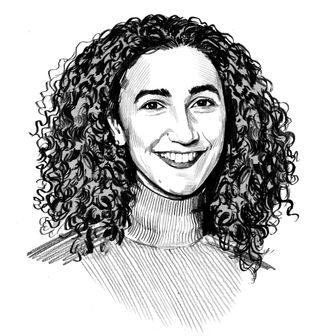Steven Sebring does not look like the kind of guy who could school you on the technicalities of virtual reality. He’s got stylish glasses, long hair, and the overall air of someone who prefers to talk shop with artists, musicians, and models — not techies. But his work is unique in that it combines a refined aesthetic sensibility with cutting-edge technology.
For the last 25 years, Sebring has been on a quest to “liberate the static image,” as he puts it — to capture his photographic subjects in 360 degrees, both literally and figuratively. He does this with a one-of-a-kind proprietary camera system he calls the Sebring Revolutionary System, or SRS for short, which he built in a magical old vaudeville theater on the Lower East Side. It’s where he shot actress Natasha Lyonne for the Cut’s April cover story.
“When you walk in here, you don’t think of tech; you think of art,” Sebring told me inside the space. “That’s what it’s all about.”
At the center of the theater sits the SRS stage, a round room with white walls and over a hundred cameras on the ceiling. These are all arranged in a circle and focused inward. To capture Lyonne’s image, Sebring had her step inside the circle and stand in the center, like entering a massive, futuristic photo booth in the round.
“Natasha really dug it,” Sebring said of the shoot. “She talks about the fourth dimension in Russian Doll, so I took her to the fourth dimension.”
Wait, but how does it work? When Sebring fires off all those cameras, they produce a standard, two-dimensional still image. In that way, the SRS is like any other photo set: A model poses in front of a white wall, and the photographer takes a picture. What’s different about Sebring’s work though is that he can capture the subject from every vantage point, in a full revolution. Then, he stitches everything together to produce multidimensional media — including still images, moving images, and interactive images that can be used in holograms, and in virtual and augmented reality.
The results look and sound complicated, like flashy special effects, but they’re not. “It’s pure photography,” said Sebring. “There’s no falseness to it; it’s not fake.” You’re simply looking at a different, more layered kind of image. If you can get past the tech part, it’s arguably more natural than the alternative, as it brings the subject to life.
Sebring’s work can be hard to wrap your head around; we’re so used to seeing flat images on flat screens. But he thinks his goal — to capture the spirit and essence of larger-than-life personalities like Lyonne — is an obvious one for any working artist. Sebring just has the advantage of figuring out the tech part, and treating it like any other creative tool.
“It’s a no-brainer when you think about it,” said Sebring with a shrug.







